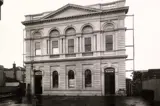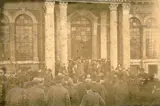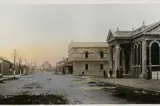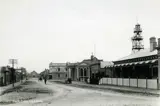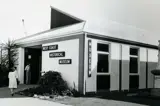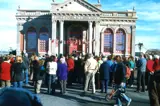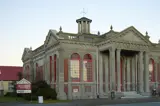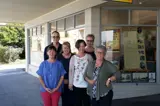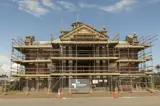The Museum's history
Hokitika’s first Museum was established in 1869 in two rooms on the upper floor of the Town Hall on Revell Street. It held scientific specimens such as stuffed birds, rocks and plants, and a collection of Victorian curiosities.
In 1908, the Museum was transferred to a room in the newly built Carnegie Library Building and was opened intermittently by library staff.
The Museum was closed in 1947 when the room was needed for Council offices. Some of the collection was put into storage but much of it was dispersed to other Museums. In 1960, the ‘Hokitika Pioneer Museum’ officially reopened in the same room with new displays. By now, the Carnegie Library Building was in a poor state of repair and not really suitable to house a museum. Fortunately, Bob Drummond had established a museum committee in 1952 with the aim of raising funds for a purpose-built museum facility.
In December 1973 the museum moved into new premises behind the Carnegie Building which had been funded by public subscriptions, service club fund-raising and a grant from the Department of Internal Affairs.
The renamed ‘West Coast Historical Museum’ employed its first director and was run by a committee which included representatives from Westland Borough Council and Westland County Council. When the two councils amalgamated in 1989, the Museum became part of the new Westland District Council.
The Museum today
While our Research Centre is open Monday to Thursday each week, the building that houses our main exhibitions is currently undergoing earthquake strengthening work.
Our new displays are being developed to capture the imagination of all ages, but with a particular emphasis on reaching and enthusing younger people about our colourful local history. Keep an eye on our website and social media sites for updates on when Nga Whakatūranga (exhibition galleries) will re-open.
The Museum takes its responsibilities of the guardianship of our local taonga very seriously. The Museum team are professionally trained in Museum and heritage practices to ensure the long term preservation, curation and public access to the collection.
Hokitika Museum's vision and future
Our Vision at Hokitika Museum is 'Hei whakahaumako te tangata - Enriching today and tomorrow's people'.
The Hokitika Museum mission is to tell the stories of Westland, the wider West Coast and its people.
Our collection reflects the life of our communities in the extreme and inspiring place that is Te Tai Poutini-West Coast, New Zealand.
